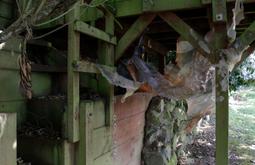"Biobitumen—a greywacke love poem (2019), is a short film and site-responsive installation made in collaboration with Rachel O’Neill and Johanna Sanders for the CIRCUIT / AURA Festival in Newtown Te Whanganui-a-tara (2019). It uses a bacterial polyester and polylactic acid blend of polymers extruded in collaboration with Beatrix Theobald and Dawn Smith at Scion, a crown research institute in Rotorua, Aotearoa New Zealand. This PhD research collaboration is funded through Massey University. The pigments are sourced from the disused Owhiro Bay Quarry on Wellington’s South Coast, along with other plant and mineral pigments that resonate with that geology. The extruded material is then heat-pressed into composite pieces that are reconfigured using a heat gun, manipulated in response to site.
The Owhiro Bay Quarry was a predominant aggregate source from the 19th C through to the late 20th C, greywacke rock from the coastal site is now found redistributed, within the roading and building materials of Pōneke Wellington city. The film was made in the gutter along a main thoroughfare, where Owhiro Bay greywacke is likely present in the 20th century curbstone still present at the site. The bacterial polyester and PLA blend is a smart material, with shape memory. Further research and filmmaking is being undertaken to develop the possibilities of this four-dimensional painting medium."
* The name biobitumen refers to shifts in the roading and coating industries toward actual biobitumen, specifically the Ngai Tūhoe iwi-led Road to Nature project in Aotearoa. During the 2000’s, Aotearoa-based artist Scott Flanagan made a series of artworks using conventional bitumen and these have influenced my understanding of the Biobitumen work.
